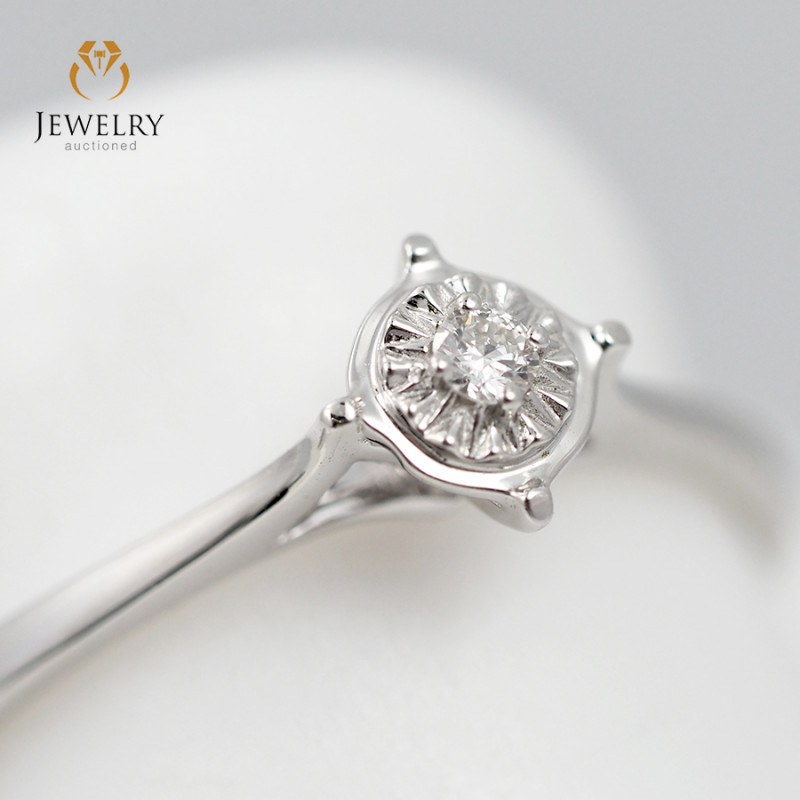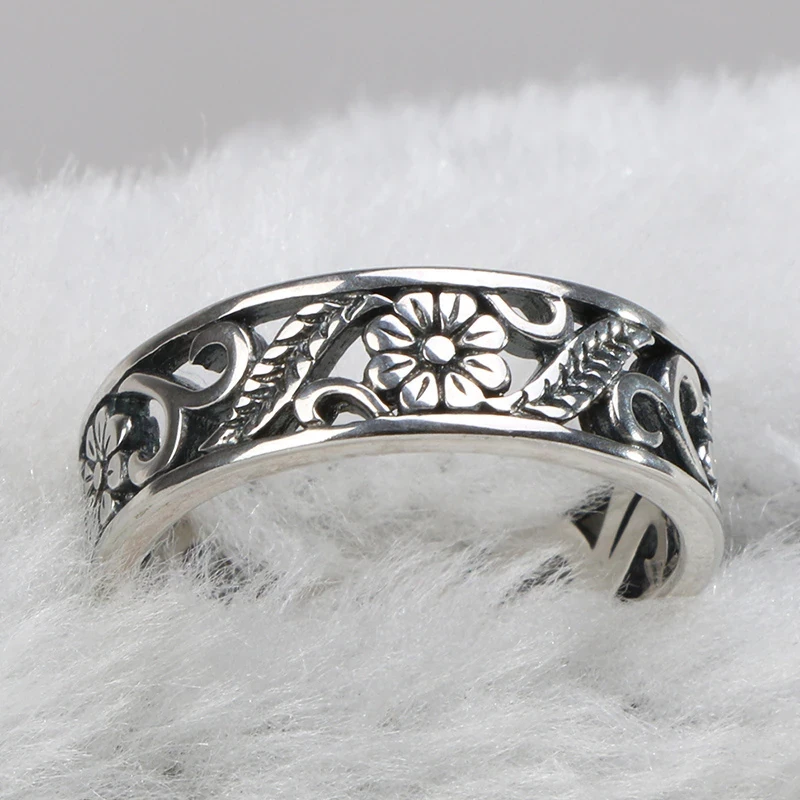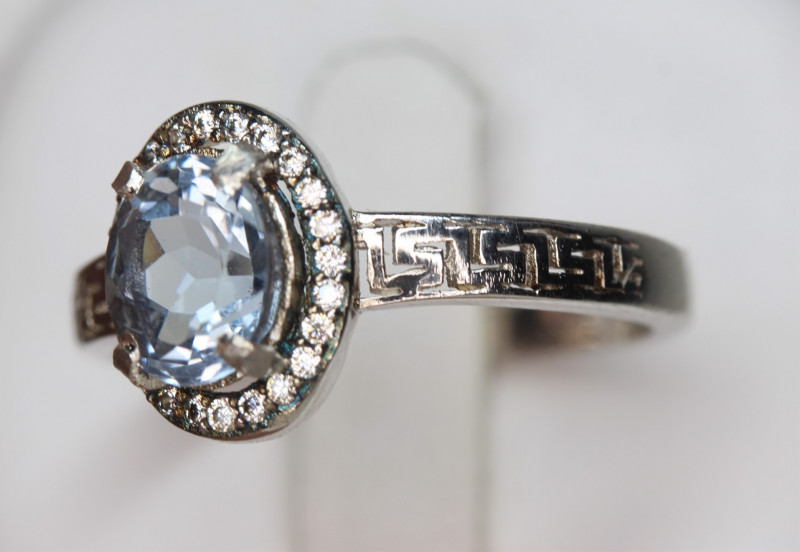
What Is Rhodium-Plated Jewelry? A Complete Guide
 Rhodium-plated jewelry has a layer of rhodium over a base metal that gives the piece a whiter, brighter finish and extra durability. You’ll often see rhodium plating on white gold jewelry.
Rhodium-plated jewelry has a layer of rhodium over a base metal that gives the piece a whiter, brighter finish and extra durability. You’ll often see rhodium plating on white gold jewelry.
Is rhodium-plated jewelry good? Absolutely! Rhodium plating can improve the jewelry’s shine, mask imperfections, and protect it from scratches. However, there are some pros and cons to rhodium plating.
Today, we’ll fill you in on what exactly rhodium plating means, how it compares to other metals, the types of rhodium-plated jewelry, and some buying factors to be aware of.
First, let’s go over some basics.

Rhodium & Rhodium Plated Meanings
Before we get into rhodium plating, let’s establish what rhodium is.
Rhodium is an element and one of the six PGMs, or Platinum Group Metals. This group also contains platinum, palladium, ruthenium, iridium, and osmium. All six metals have similar properties that make them popular for both industrial and jewelry uses.
Here are some quick facts on rhodium’s properties:
Color: Silvery white
Melting Point: 2237 K / 1964 °C / 3567 °F (higher than platinum)
Density: 12.41; 10.7 when liquid (lower than platinum)
Mohs Hardness: 6 (same as titanium, higher than other precious metals like gold and silver)
Refractive Index: 2.15 (high; reflects up to 80 percent of light)
Highly resistant to corrosion
Chemically inert (not reactive)
Unfortunately, rhodium is extremely rare and one of the most expensive metals in the world.
That means rhodium it’s too expensive to make solid rhodium jewelry, but it’s great for plating over other metals. On that note, what is rhodium plating?

Rhodium Plating
Rhodium plating — also called “rhodium dip” or “rhodium flashing” — is the process of covering a base metal with a coating (or “plating”) of rhodium. The base metal is usually silver or gold, particularly white gold.
The process is called electrolysis or electroplating — the same process used to create gold vermeil and gold-plated jewelry.
It starts with cleaning and preparing the base metal or jewelry piece to remove contaminants and make the rhodium adhere better. The prepped piece is attached to a negatively charged cathode bar and dipped into a positively charged solution containing rhodium particles.
The jeweler runs an electrical charge through the solution, making the rhodium particles bond to the base metal.
The proper thickness of the rhodium layer is crucial, as rhodium is hard but brittle. Ideally, the best rhodium layer is 0.75 to 1 micron thick (1 micron = 0.001 mm). Thinner layers can expose the base metal, while thicker layers can cause the rhodium plating to crack.
How long does rhodium plating take? Not long! Most jewelers can apply a rhodium coating in around 90 minutes, though more complex pieces (like jewelry with softer gemstones that need to be removed first) may take longer.
Now that you know how rhodium plating works, we’ll go over the types of rhodium-plated jewelry you may come across.

Types of Rhodium-Plated Jewelry
The most common type of rhodium-plating is on white gold, but rhodium can be plated onto all shades of gold, along with other metals like silver and platinum. That said, you’ll typically see rhodium plating on gold or silver.

Rhodium-Plated Gold
Rhodium-plated gold can be any karatage, from 10K to 24K. Higher karatage gold base metals mean higher value.
As mentioned above, rhodium-plating on white gold is the most common. White gold is an alloy (mixture) of pure yellow gold and metals like nickel, zinc, palladium, copper, or silver. Usually, the added metals are nickel, palladium, or silver.
Despite the whiteness brought by these additional metals, white gold will still look somewhat yellow. Rhodium-plating white gold gives it a lustrous, more pure silvery white appearance.
You can also add rhodium plating to yellow gold or rose gold, but rhodium-plated rose gold is less common.
In the case of black gold, this shade is often created by electroplating black rhodium to yellow gold. Black rhodium is an alloy of rhodium and metals like ruthenium, tin sulfide, arsenic trioxide, or tellurium oxide to the rhodium. The result is a dark gray, black, or gunpowder-colored metal — the exact shade depends on the alloys added to the rhodium.

Rhodium-Plated Silver
Rhodium-plated silver almost always has a sterling (925) silver base. Though both metals are precious, rhodium plating adds some pizazz, protection, and longevity to silver jewelry.
Not only is rhodium harder than gold, but it’s also harder than silver, so rhodium-plating silver adds a layer of protection from scratches. Rhodium is also whiter and brighter than silver, creating a more lustrous appearance.
Additionally, a rhodium-plating can prevent the silver from oxidizing. While oxidized silver can be desirable for an antique look, tarnished silver is slightly toxic to wear.
If the silver jewelry incorporates gemstones, rhodium plating can even bring out the stones’ sparkle.
All that said, rhodium-plated silver will be more expensive than plain silver jewelry.
On that note, let’s see how rhodium-plated jewelry compares to the competition.
Rhodium Plating vs. Similar Metals
Before you buy rhodium-plated jewelry or have your jewelry rhodium-plated, you might wonder how it fares in competition with other styles.
First, is rhodium-plated better than sterling silver?
 Pictured above: Sterling silver ring
Pictured above: Sterling silver ring
Rhodium-Plated vs. Sterling Silver
We’ll compare rhodium-plated sterling silver to unplated sterling silver first. In terms of durability, rhodium-plated silver jewelry will last longer, not tarnish, and not scratch as easily. That said, solid sterling silver jewelry will not need to be replated, while rhodium-plated silver jewelry will eventually need replating.
Another consideration is appearance. While silver is quite shiny, rhodium has a better luster that generally lasts longer.
Overall, we’d say rhodium-plated silver is better than sterling silver in terms of appearance and longevity, but rhodium-plated jewelry’s higher price and the eventual replating cost are important factors to consider.
 Pictured above: 3 unplated white gold rings below a silver ring | Image credit: Simone Walsh on Flickr
Pictured above: 3 unplated white gold rings below a silver ring | Image credit: Simone Walsh on Flickr
Rhodium-Plated vs. White Gold
Like rhodium-plated silver, rhodium-plated white gold will be whiter and brighter than unplated white gold. However, comparing the two is tricky, as most white gold jewelry has been rhodium-plated.
In fact, if you’re wondering how to identify rhodium jewelry from unplated white gold jewelry, color is key. New, unplated white gold will be slightly yellow, an indicator that it’s not rhodium-plated. That said, the rhodium plating on white gold can wear off, revealing that slightly yellow hue underneath.
Historically, the only way to create white gold was with rhodium plating — that is, until better alloy mixtures came along.
So, is rhodium-plated better than white gold?
If you want a brighter, cooler-toned white with extra protection from tarnishing, rhodium-plated white gold is the way to go. However, those with warmer skin tones may prefer the warmer white hue of unplated white gold. Also, like the silver comparison above, the jewelry and replating costs are important to consider.
Speaking of buying factors, let’s discuss the pros and cons of rhodium-plated jewelry.

Pros and Cons of Rhodium Plating
Like any type of jewelry, rhodium plating comes with advantages and disadvantages. It’s important to take both sides into consideration before deciding if rhodium-plated jewelry is right for you.
Some of the pros of rhodium-plated jewelry include:
Brighter, pure white finish
Higher luster and shine than most metals
Luster won’t fade as quickly
Greater scratch-resistance
Won’t dent
Hypoallergenic (nickel-free)
On the other hand, some of the cons of rhodium-plated jewelry include:
Often more expensive
Will eventually wear off, unlike unplated jewelry
Cannot be resized or fixed (coating will melt off)
Requires replating
Replating is a big factor in the value and maintenance of rhodium-plated jewelry.

Rhodium-Plated Jewelry Value
First, is rhodium-plated jewelry valuable? Definitely. Besides the many pros listed above, the rhodium alone can often sell for 10 to 25 times the price of gold.
How much does rhodium-plating cost? If you want your jewelry rhodium-plated, the cost depends on the size and intricacy of the jewelry.
For reference, rhodium-plating an engagement ring will generally cost between $50 to $100. Overall, having jewelry rhodium-plated typically costs $30 to $120.
Value-wise, however, rhodium’s market price goes up and down. Since it’s only mined as a byproduct of platinum ore, the demand for platinum can affect the availability of rhodium. Therefore, using rhodium as an investment isn’t a super stable option.
That said, having your jewelry rhodium-plated is a good investment for protecting it. Of course, you still have to take care of it!
How Long Does Rhodium Plating Last?
Does rhodium plating wear off? Yes, any jewelry plating will eventually wear off due to contact with your skin’s chemicals, abrasion, and exposure to various environmental factors.
Now, does rhodium-plated jewelry tarnish? Pure rhodium will never tarnish, though rhodium alloys can. If the rhodium plating on silver jewelry starts wearing off, the silver underneath can start tarnishing via oxidation. For rings, you’ll often see the discoloration start on the bottom.
Once the rhodium plating wears off, you’ll need to get it replated to restore its appearance and durability. Jewelry like rhodium-plated rings often needs replating every six months to 3 years, depending on how often you wear them.
Overall, rhodium plating will last between 12 to 18 months before you start seeing signs of wear. The longevity can also depend on the type of jewelry; earrings and brooches are less vulnerable than rings and bracelets, as they don’t get as much friction or contact with body oils.
You can extend the life of your rhodium plating — and save money on more frequent replating — with proper maintenance.

Caring for Rhodium-Plated Jewelry
Proper care of rhodium-plated jewelry means knowing when to remove your jewelry, how to clean it, and how to store it.
Can you wear rhodium-plated jewelry in the shower? Technically, yes. But the chemicals in shower products can wear down the plating, so it’s better to remove the jewelry first.
In fact, it’s best to remove rhodium-plated jewelry before:
Showering
Washing your hands
Swimming
Cleaning
Exercising
Putting on cosmetics (e.g. makeup, perfume, lotion)
Any activity that involves harsh chemicals, like removing nail polish
The main issue isn’t water but friction and chemicals, which can both wear down the plating. Water won’t tarnish pure rhodium
After you take your jewelry off, wipe it down with a clean, microfiber cloth (like a lens cloth) to remove any oils or moisture.
Besides wiping it down after each wear, you’ll also want to give it a deeper clean once every week or two, depending on how frequently you wear it.
How to Clean Rhodium-Plated Jewelry
Do NOT clean rhodium-plated jewelry with harsh chemicals like ammonia or abrasives like toothpaste.
Instead, follow these steps:
In a plastic bowl, mix 1 cup of lukewarm, distilled or bottled water with ⅓ cup of mild soap.
Submerge your rhodium-plated jewelry in the mixture and leave for around 10 minutes, no longer than 15 minutes.
Dip your fingers in and gently wipe away any dirt or debris from the jewelry.
Plug your sink and rinse off any soap residue with distilled or bottled water.
Lay the jewelry on a soft cloth (like microfiber) and gently pat it dry. Avoid rubbing as much as you can.
If you have soft tap water, you can use that instead of distilled or bottled water. You just want to avoid any added minerals in the water.
Store each jewelry piece separately by wrapping it in a soft cloth or resealable plastic bag, then keeping that in a dry, temperature-stable container.

Shine Bright in Rhodium-Plated Jewelry!
Rhodium-plating gold, silver, or other metals offers a myriad of benefits both aesthetic and protective. Whether you want to shine bright in pure white gold or simply make your sterling silver last longer, rhodium plating is a great way to do it!
Ready to shop? Browse our collection of beautiful jewelry today!
Search the Fashion Encyclopedia
Related Auctions
Related Articles
How to buy a ruby for your ring or pendant,Make sure that you learn as much as you can about Rubies, prior to buying a ring or a setting that you are going to add Rubies to. Like Diamonds, Rubies can be flawed, and imperfect The Ruby is one of the most b
10th Apr 2019
jewelry polish cloth,A magic cloth just doesn’t exist. That being said, there are cloths for silver, gold, platinum, bronze, copper, stainless steel and other metals. Each one should be impregnated with special treatments and chemicals targeted at
10th Apr 2019
Latest Articles
Titanium is a popular jewelry metal known for being lightweight, durable, and affordable. Learn all about titanium, how it compares to similar metals, and the pros and cons of titanium jewelry.
7th Feb 2023
Learn all about tungsten jewelry - from its history and uses to its durability and care. By the end of our guide, you’ll know if tungsten is right for you!
7th Feb 2023
Thinking about adding some timeless white gold jewelry to your fine accessories collection? Here’s all there is to know about sophisticated white gold!
29th Jan 2023








